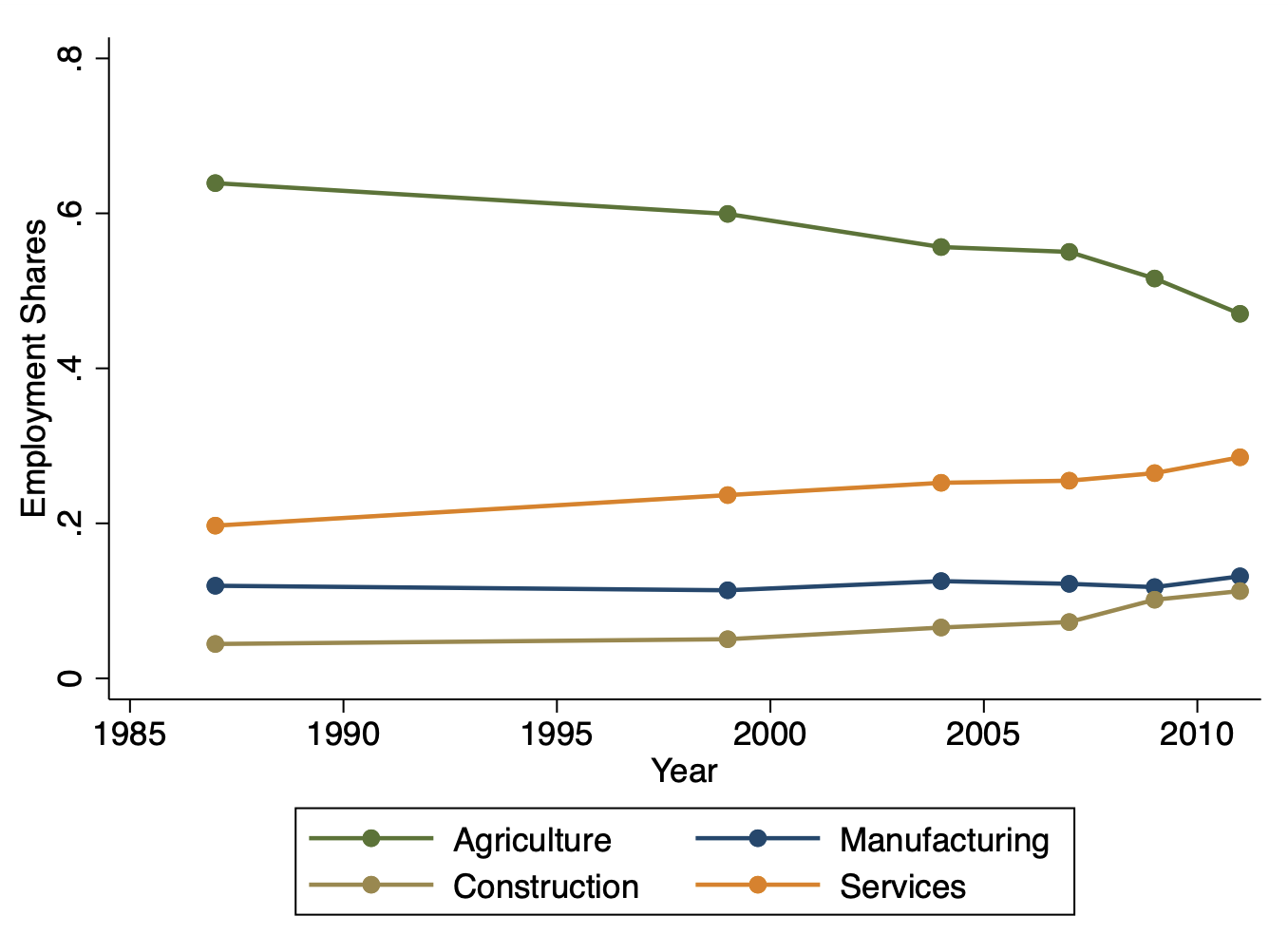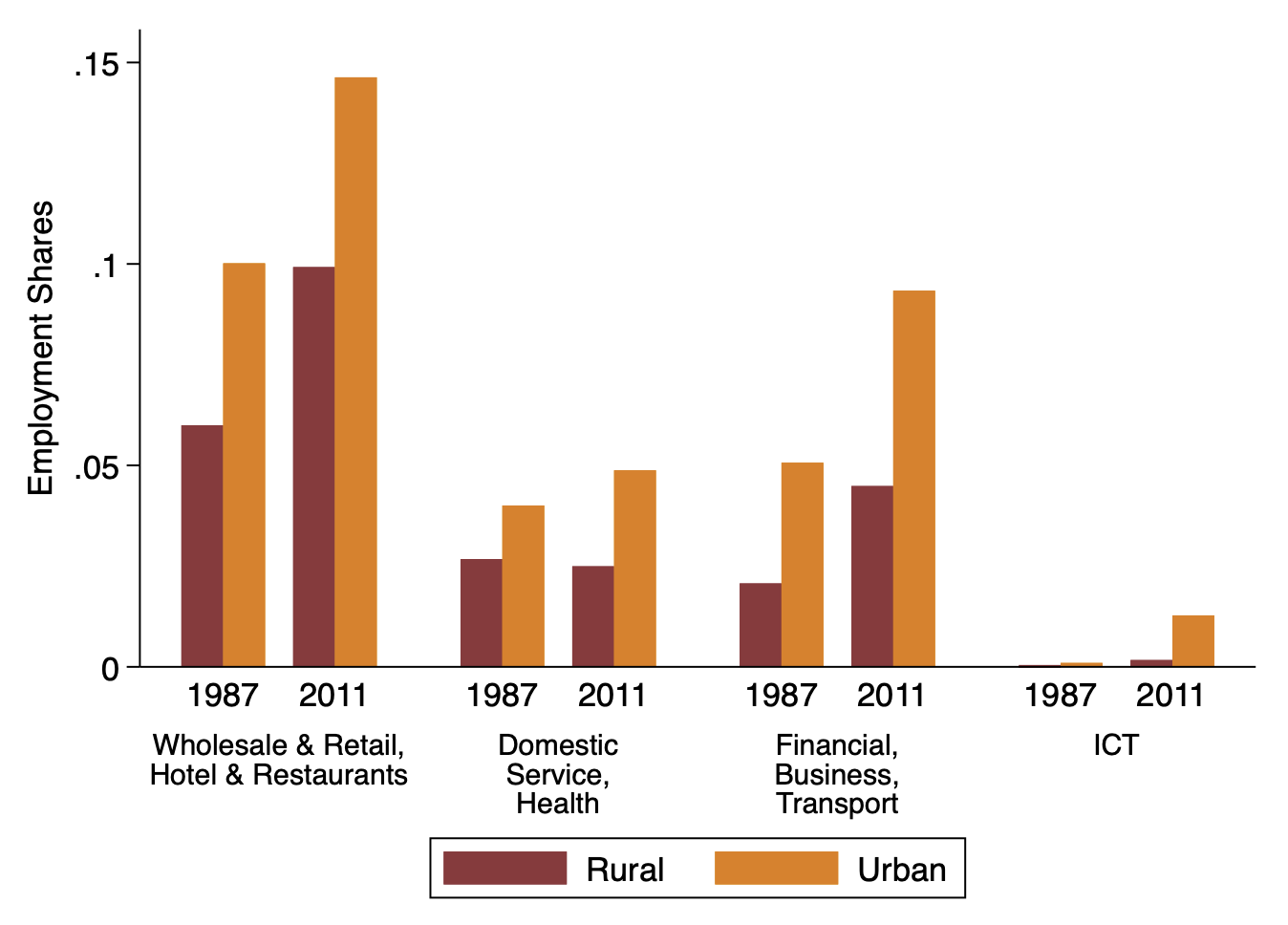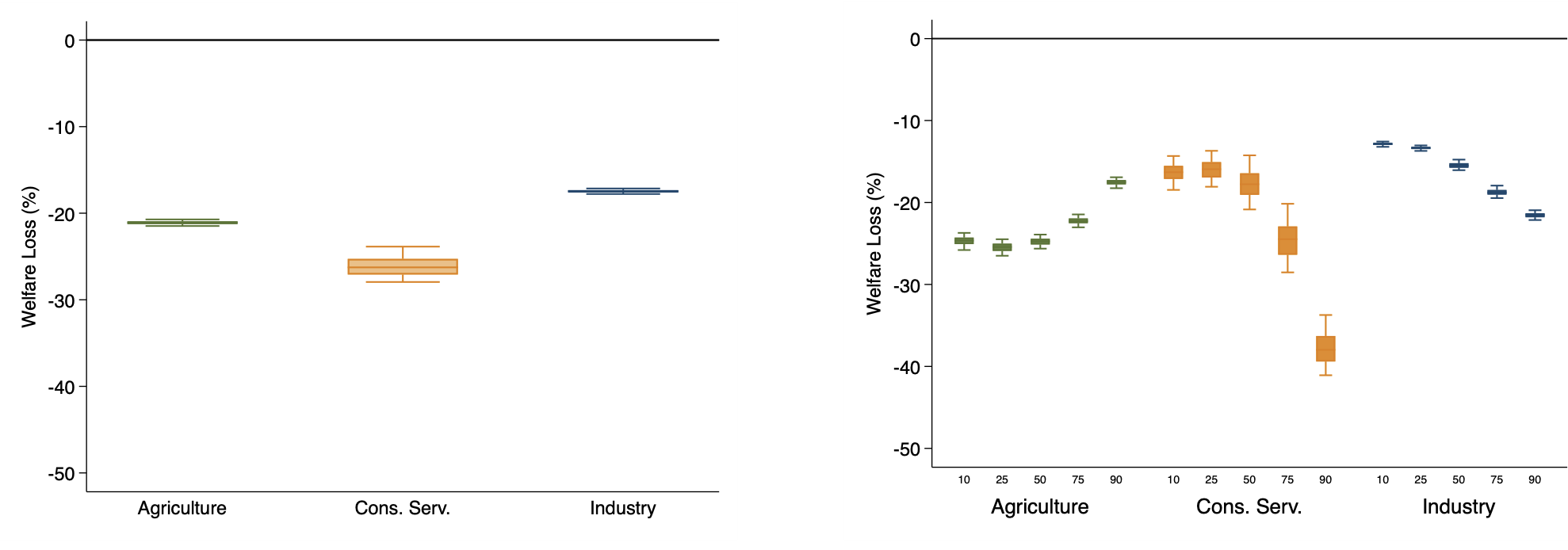
Service-led growth can be a viable development strategy for the developing world; however, its fruits might disproportionately benefit the rich
The structural transformation of industrialised countries has historically been remarkably similar across the world. In early stages of development, a growing industrial sector drew labour from a declining agricultural sector, and at a later stage, the employment shares of both agriculture and manufacturing decreased, while services — which included employees like janitors, grocery store clerks and accountants — became the main source of employment growth (Herrendorf et al. 2014).
While this pattern fits the historical experience of most Western and East Asian economies fairly well, today, the economic development in most developing countries appears to be taking a different path. In fast-growing economies like India and several countries in sub-Saharan Africa, the share of manufacturing jobs has barely grown and the structural transformation has shifted employment straight from agriculture to services.
Figure 1 displays this pattern for India between 1987 and 2011 — a period during which income per capita increased by a factor of almost three.1 While the agricultural employment share declined substantially, manufacturing employment was entirely stagnant and the service sector (and to a lesser extent, the construction sector), absorbed the workforce leaving the fields.
Figure 1 Sectoral employment shares in India: 1987–2011

This pattern of "premature de-industrialisation" (Rodrik 2016) is a cause of concern to many scholars. Technical progress in manufacturing is traditionally seen as the main engine of growth and an expanding service sector might be a pale substitute. Indeed, the growth of the service sector is for many a mere corollary of economic development, whereby rising incomes increase the demand for services.
Can the service sector then also be a source of productivity growth per se, and hence present a viable development strategy for today’s developing world? In our recent study on service-led growth in India (Fan, Peters and Zilibotti 2021), we conclude that economists and practitioners might be overly pessimistic about such a possibility. Using a new methodology that allows us to infer productivity growth from micro data on employment, wages, and human capital, we document that productivity growth in the service sector has been substantial and can account for about one third of aggregate welfare gains since the late 1980s. However, such productivity gains were strikingly unequal and benefitted particularly rich consumers living in cities.
The service sector in India: Consumer and producer services
Any attempt to measure productivity growth in the service sector faces two important challenges. First, in many service industries, it is difficult to estimate total factor productivity. Second, the service sector encompasses a range of very heterogeneous activities; indeed, retail workers, consultants, IT specialists, and domestic housekeepers are all classified as service workers.
In our approach, we distinguish between different types of services according to the nature of the typical buyer and whether the value added created by such services is tradable. On one end of the spectrum are retail employees whose services are non-tradable and almost entirely demanded by local consumers. We dub these services consumer services. On the other end are corporate lawyers and ICT workers who often cater to other firms. We call these producer services; they are akin to intermediate inputs and their value added is tradable.
Figure 2 shows how the employment share in these different activities has evolved over time and varies between rural and urban districts in India. Three patterns are noteworthy. First, employment increased in all service activities. Second, services are particularly concentrated in cities. While this “urban bias” is especially pronounced in producer services like ICT or the provision of financial services, it is also apparent in traditional consumer service categories like retail and hospitality. Third, even though India is often hailed as a producer service hub with its call centres and expertise in ICT, consumer services still comprise the lion’s share of its service sector.
At first glance, this might look like evidence in support of the pessimistic view. Indeed, there may be technical progress in the financial sector, but what about the wholesale and retail industries? However, before drawing any conclusions, it might be worth noting that recent research argues that even in the US, the expansion of high-productivity firms in the retail sector has been an important source of growth (Hsieh and Rossi-Hansberg 2020).
Figure 2 Composition of the service sector in India

Service-led or service-biased growth?
Is the employment growth in services shown in Figure 2 a source or a mere consequence of development? To answer this question, we tackle a fundamental identification issue. Because consumer services are ‘luxuries’ – i.e. the expenditure share on them increases with income – the share of retail employment could be higher in cities simply because city dwellers are richer. However, an alternative (or complementary) hypothesis is that cities are service-rich because services (even traditional ones) are more productively provided there. Similarly, the rising employment share over time may reflect rising incomes (‘service-biased’ growth) but could alternatively reflect sector-specific productivity gains (‘service-led’ growth).
Our key source of identification is the income elasticity of consumers’ service demand; in other words, if income increases by 1%, by how much does spending on consumer services increase? In our study, we estimate this elasticity using micro data on consumption expenditures and incorporate non-homothetic preferences consistent with this elasticity into a general equilibrium model of economic geography. We then use this model as an accounting framework to estimate productivity growth in agriculture, manufacturing, consumer services and producer services for roughly 400 Indian districts since 1987.
The large and unequal welfare impact of service-led growth in India
Our main finding is that productivity growth in services — even traditional ones — must have been large to explain the extent of ‘tertiarisation’ in the Indian economy. In other words, growth was largely service led. Using our estimated model, we can also quantify the welfare effect of productivity growth in the service sector and compare it with that of other sectors. More precisely, we ask the following question: suppose no productivity growth had been taken place between 1987 and 2011 in a particular sector. By how much would this have reduced real income of consumers in 2011?
In the left panel of Figure 3 we report this number for the average consumer in India.2 The salience of service-led growth is apparent: real income would have been 30% lower if productivity in services had been stagnant since 1987. Hence, the welfare impact of service-led growth is similar to that of productivity growth in agriculture and larger than the aggregate impact of industrial productivity growth. These differences are both economically and statistically significant as seen in the confidence intervals that our methodology, which is based on micro data, allows us to compute.
Overall, this is good news for economic development of India. The lack of a pronounced industrialisation does not mean that growth is bound to fall. A sourer bit of news is that service-led growth is strikingly pro-rich. In the right panel of Figure 3, we break down the welfare gains across five quantiles of the income distribution. While growth in consumer services accounts for almost 40% of real income growth for consumers at the top of the income ladder, this effect is only half as large for consumers below the median. The exact opposite is the case for productivity growth in the agricultural sector, whose main beneficiaries are low-income households.
Figure 3 Source of growth: Aggregate and distributional consequences

Two factors lead to this stark discrepancy. First, rich consumers spend a larger share of their income on services, while agricultural goods are necessities and thus particularly relevant for poor households. Second, most services are local goods and productivity growth in services is higher in urban locations where the average household is richer.3
Implications and open questions
Our findings imply that productivity growth in the service sector was an integral part of India’s growth trajectory. Understanding how exactly this productivity growth came about is a question of first-order importance, in particular when we think about policies. Moreover, is service-led growth unique to the Indian experience or is it also important in other developing countries? If so, the absence of employment growth in the manufacturing sector might be less concerning than previously thought.
References
Fan, T, M Peters and F Zilibotti (2021), “Service-Led or Service-Biased Growth? Equilibrium Development Accounting across Indian Districts” , NBER Working Paper 28551.
Herrendorf, B, R Rogerson and A Valentinyi (2014), "Growth and structural transformation", Handbook of Economic Growth 2: 855–941.
Hsieh, C T and E Rossi-Hansberg (2019), “The industrial revolution in services”, NBER Working Paper 25968.
Rodrik, D (2016), “Premature Deindustrialization”, Journal of Economic Growth 21(1): 1–33.
Endnotes
1 The data on income growth is taken from the World Bank found here. To put this in context, this corresponds to about 50 years of growth at a rate of 2%, the historical rate of economic growth in the United States.
2 As explained above, producer services are an input into the production of manufacturing goods. The results for the industrial sector shown in Figure 3 are therefore the combination of productivity growth in manufacturing and in producer services. In the paper, we show that the direct role of producer services is quantitatively small.
3 Our conclusions remain true when we account for the growth of export services, most notably, in the IT sector. These services are clearly not local goods, and their importance is growing over time. Yet, considering their importance does not alter our main conclusions — at least until 2011, which is the endpoint of our study.


